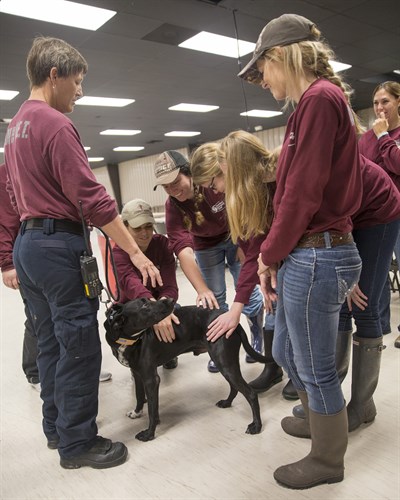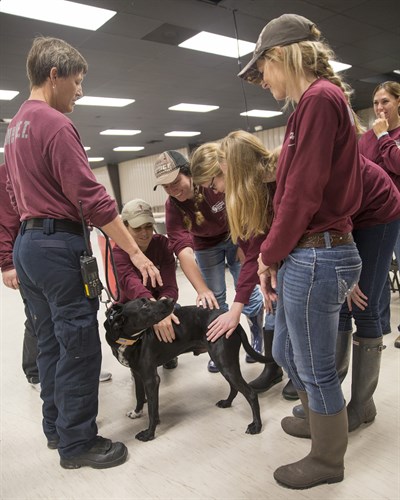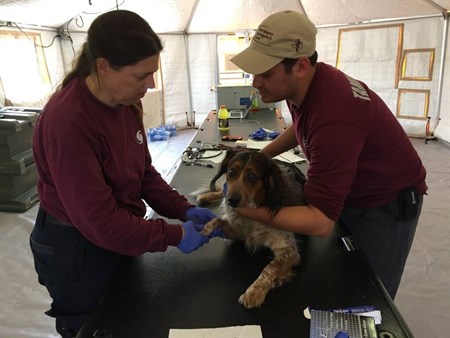Texas A&M’s Veterinary Emergency Team Assists in Hurricane Harvey Search and Rescue
COLLEGE STATION, Texas – The Texas A&M Veterinary Emergency Team (VET) is offering medical support to urban search-and-rescue task force canines and other injured or stranded animals at the request of multiple areas along the Texas coastline that have been negatively impacted by the extreme flooding resulting from Hurricane Harvey.


A team of four deployed on Aug. 25 to the Rockport, Texas, area to care for the search-and-rescue canines used in the Texas Task Force 1’s (TTF1) recovery efforts in the ravaged city.
On Aug. 28, a second team of 21, including five fourth-year veterinary students on the VET rotation at the Texas A&M College of Veterinary Medicine & Biomedical Sciences (CVM), deployed to join the four in Aransas Pass, Texas, when the Federal Emergency Management Agency (FEMA) reassigned TTF and VET to Fort Bend County to assist with the extensive flooding in the Houston metroplex.
Since reaching Fort Bend County, the VET has overseen the treatment and care for large animals sheltered on site; has accepted more than three dozen companion animals for evaluation and treatment; continued to care for the TTF1 and TTF2 search-and-rescue canines; coordinated with emergency management officials on areas of concern; and continued instruction with the VET rotation students, highlighting the specialty care required for search-and-rescue canines, as well as in the areas of emergency care triage and inventory control.
Also since then, smaller teams have branched out to other areas requesting medical support and assistance, providing day support to search-and-rescue canines that are part of a in FEMA-supported Incident Support Team in Katy and deploying to Chambers County, as well as back to Rockport.
“The damage and destruction from Hurricane Harvey has been a challenge for all response groups,” said Dr. Wesley Bissett, founding director of the VET. “Now that the water is receding, more animals that were not evacuated are being located and brought to local sheltering operations. The VET is supporting these animals by providing triage and assessing any injuries and health status, providing treatment when necessary, and ensuring these animals are sheltered locally in a safe place so they can be reunited with their owners.”
The flood waters are especially problematic for the search-and-rescue canines, as well as resident animals, in that these waters are very contaminated. The VET developed a special decontamination unit to assist in removing the contaminants from the search-and-rescue dogs and other small animals brought to the VET base of operations.

The team’s care for the TTF1 and TTF2 search-and-rescue canines is critical as they venture into the dangerous debris left in the aftermath of natural disasters in search of trapped humans.
One TTF2 member said that when on the scene, handlers are often focused on the dogs’ reactions in guiding them to find the lost or missing but that handlers sometimes miss the nuances that can indicate their dog may be injured, such as a slight limp or change in gait.
“The search and rescue dogs work in really challenging environments; they have to search in mud, debris, and even downed power lines. They maneuver themselves into places where humans can’t go, and because of that there are some immediate risks,” said Angela Clendenin, VET public information officer. “Taking good care of their medical needs and making sure they are healthy before they leaver our base allows them to be more efficient in the field, which means they can continue to work hard saving lives.”
VET members anticipate being deployed for at least a month in multiple locations as requested by county and community officials and response partners.
“It’s humbling to be invited into a community, or to be invited to partner with another response team like Texas Task Force 1, to do our part and to help the citizens of Texas in their time of need,” Clendenin said.
The College of Veterinary Medicine & Biomedical Sciences has set up the Veterinary Emergency Disaster Fund, with proceeds benefiting the VET. Visit https://vetmed.tamu.edu/vet/giving/ for details.
Those interested in the VET’s actions on deployment can follow the VET on Facebook.


